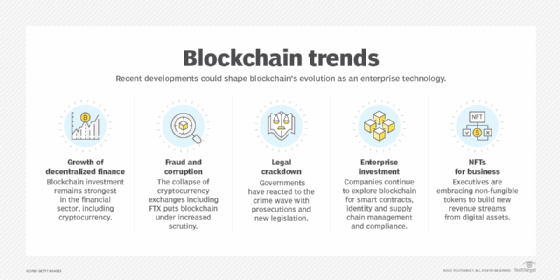Top Web 3.0 trends and predictions for 2025 and beyond
The next-generation internet is taking longer than expected. But blockchain improvements and a favorable regulatory climate for cryptocurrency are positives for the coming year.
Generative AI might be grabbing all the headlines and launching thousands of pilot projects, but technologies surrounding the next generation of the internet are still making progress. While the hype largely died down in 2024, the adoption of Web 3.0 technologies proceeded, albeit more slowly than most industry observers had predicted in recent years.
For example, despite tokenization being heralded as a game-changer for digital ownership and asset management, enterprise use of non-fungible tokens (NFTs) has yet to take off in a significant way as doubts about return on investment endure.
Nevertheless, blockchain has become more efficient thanks to the growth of Layer 2 infrastructure, which sits on top of a blockchain and can process transactions "off chain" more quickly while still benefitting from the blockchain's security. The improvements have brought decentralized finance (DeFi) frameworks in closer alignment with regulatory expectations.
Meanwhile, the cryptocurrency world stabilized, with fewer high-profile fraud cases and crypto exchange failures than in recent years. The sector is sure to see much activity in 2025 with the arrival in the U.S. of a pro-crypto presidential administration.
This article is part of
What is Web 3.0 (Web3)? Definition, guide and history
The upcoming year might thus prove to be a watershed moment for Web 3.0 as it finds its footing in real-world applications, even if more slowly than once anticipated. Here are eight Web 3.0 trends and predictions to watch.
1. Tokenization of real-world assets continues
This includes assets such as real estate, commodities, and agriculture as well as using blockchain technology to track them. "One of the big innovations of Web3 are tokens -- both fungible and non-fungible assets that are inherently unique -- and the ability to program them with smart contracts that track them," said Avivah Litan, an analyst at Gartner. Litan said she sees a lot of movement globally, including in Abu Dhabi in the United Arab Emirates, where agriculture company Silal is working with nearly 1,000 farmers to track food. This enables consumers to trace the lifecycle of food products from farm to fork. Now tokenization is extending to fine art.
2. Expanded focus on cryptocurrency
The incoming Trump Administration's keen interest in crypto will bring lots of attention and activity in the coming year, said Tom Taulli, co-author of a book about agentic AI to be published in April. "The new treasury secretary is really deep on crypto, and they're bringing in someone at the Securities and Exchange Commission who is pro crypto. So in the coming year there will probably be a lot less regulation and a freer hand on crypto, which probably means we're going to see a lot more of it."
But more fraud and crime tend to come along with fewer regulations. If that happens, Taulli said, public trust in crypto will likely be reduced and, with it, adoption rates. "Regulation helps this industry because it builds trust," he added.

3. Enterprise use of tokenization disappoints
Last year, Litan was among the analysts seeing growing use of tokenization for things like supply chain monitoring and financial applications. But in 2024, brands backed off building immersive experiences using NFTs as they struggled to find a way to make them profitable, according to Taulli.
4. Web 3.0 adoption continues to be slower than predicted
Last year, Gartner revised its Web 3.0 estimates downward, predicting that 25% of enterprises will use centralized services wrapped around decentralized Web 3.0 applications by 2027. Gartner hasn't updated its Web 3.0 adoption estimate. But it seems clear that AI efforts are now taking precedence over Web 3.0, and this will continue to be true for the next few years, Litan said.
5. DeFi use increases
DeFi applications enable users to pay for things or send money without the involvement and fees of a traditional bank. "There's still a lot of inefficiency in traditional financial systems," Taulli said. "That's where there has been a lot of interest in DeFi."
DeFi users can borrow, lend and trade cryptocurrencies as well as speculate on asset prices through derivatives. Consumers are using DeFi for everything from paying for e-sports to sending money abroad, and its use is expected to increase, according to Fortune Business Insights.
6. Stablecoins are on the rise
A stablecoin is a tokenized digital asset whose value is tied to a less volatile asset, such as the U.S. dollar or gold. Cryptocurrencies such as Bitcoin can fluctuate wildly over short periods of time, so stablecoins are an important development and should drive more DeFi activity, Taulli said.
7. Blockchain validation continues to be resource intensive
"Proof of work" is an expensive, energy-intensive process that requires miners to do complex mathematical calculations to verify blockchain transactions. Now, Ethereum, a popular open-source blockchain platform, uses a less costly validation mechanism, another type of consensus algorithm called "proof of stake" for its blockchain, according to Taulli. That's imperative, given the exploding demand for electricity associated with AI.
"AI is going to melt the electric grid at some point," he said. "They're building nuclear power plants to power these data centers because AI is taking up so much power. But crypto also takes data center energy. Moving away from proof of work is an important step. Proof of stake is a lot more efficient, and costs have come down some."
8. Content creators will transition from Web 2.0 to Web 3.0 platforms
In the traditional internet paradigm, content creators had no choice but to get their work out into the world via platforms owned by large companies such as Google, Twitter and Apple. They were at the whim of what the tech giants wanted to do with their data, said Chris Dixon in a YouTube video. Dixon is a general partner in the venture capital firm Andreessen Horowitz and author of Read Write Own: Building the Next Era of the Internet. With Web 3.0, by contrast, content creators will be able to use platforms like Substack that do not own their data.
"We're still relatively early in that process," Dixon said. "I think in the next couple of years, we'll see some really interesting developments."
Lauren Gibbons Paul has covered technology topics for IT publications including CIO, CSO, Computerworld, Network World and eWEEK for more than 20 years. She specializes in the application of technology to drive business value.








